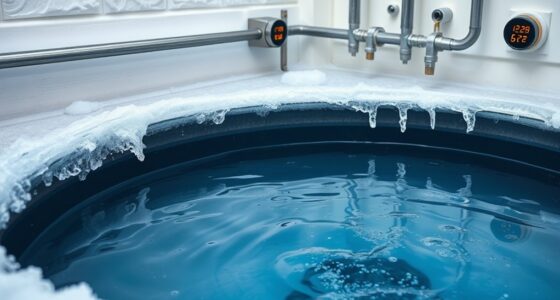When bather loads increase, you introduce more sweat, oils, lotions, and dirt into the water, which disrupts chemical balance and makes maintaining proper sanitizer levels harder. This higher contamination risks bacteria and algae growth and puts stress on filtration systems, leading to clogged filters and less effective circulation. Regular testing, filtration maintenance, and encouraging good swimmer hygiene help keep water safe and clean. Understanding these impacts will help you manage your pool better.
Key Takeaways
- Increased bather load introduces contaminants that disrupt water chemical balance, making chemical management more challenging.
- Higher swimmer numbers elevate pathogen transmission risk, requiring vigilant disinfection and sanitizer level monitoring.
- Elevated bather presence causes debris buildup, necessitating frequent filter cleaning and proper circulation to maintain water clarity.
- Promoting swimmer hygiene, such as pre-swim showers, reduces contaminant load and supports water quality.
- Adaptive water management, including regular testing and shock treatments, is essential to sustain safe water conditions during high bather periods.

When a swimming pool or water body experiences a high bather load, the water quality can quickly decline if not properly managed. The increased number of swimmers introduces more contaminants, including sweat, body oils, lotions, and dirt, which can upset the water’s chemical balance. Maintaining the correct chemical balance becomes more challenging as these substances alter pH levels, alkalinity, and sanitizer effectiveness. If the water isn’t properly balanced, it becomes a breeding ground for bacteria and algae, creating unsafe swimming conditions. Regular testing and adjustments are essential to ensure that chemicals like chlorine or bromine stay within recommended ranges, effectively disinfecting the water and preventing unpleasant odors or cloudy water.
Pathogen control becomes even more critical during periods of high bather load. The more people in the water, the higher the chance of transmitting illnesses through bacteria, viruses, or other pathogens. Proper disinfection protocols, including sufficient sanitizer levels, are crucial to neutralize these microorganisms. Without vigilant pathogen control, you risk outbreaks of illnesses like gastrointestinal infections, skin rashes, or respiratory issues. It’s important to monitor sanitizer levels frequently and adjust as needed, especially during busy days, to keep the water safe for everyone. Shock treatments might be necessary to eliminate accumulated contaminants and ensure the water remains sanitary.
Beyond chemical treatment, you need to pay attention to filtration and circulation systems. When bather loads are high, debris and contaminants can quickly clog filters, reducing their efficiency. Regular backwashing and cleaning of filters help maintain proper water flow, ensuring that disinfectants are evenly distributed and that contaminated water is removed from circulation. Proper circulation also prevents dead spots where bacteria or algae can thrive, further supporting pathogen control efforts. In addition, encouraging swimmers to shower before entering the water reduces the introduction of dirt and oils, easing the burden on your water treatment system. Implementing adaptive water management practices, such as adjusting filtration schedules during peak times, can further improve water quality maintenance.
Frequently Asked Questions
How Does Bather Load Affect Pool Chemical Balance?
When bather load increases, it affects your pool’s chemical balance by causing chlorine stability issues and pH fluctuations. More swimmers introduce contaminants, which consume disinfectants faster and can lead to cloudy water. You’ll notice you need to adjust chlorine levels more frequently to maintain sanitation. Additionally, pH can shift, making water either too acidic or alkaline, which can irritate swimmers and reduce sanitizer effectiveness. Regular testing and adjustments are essential.
What Are the Long-Term Ecological Impacts of High Bather Loads?
High bather loads can cause ecological disturbance in surrounding environments, leading to issues like nutrient runoff that fuel algae blooms. Over time, this disrupts local ecosystems and results in biodiversity loss. You might notice reduced plant and animal diversity around the water area, as excess chemicals and contaminants from frequent use harm aquatic and terrestrial life. Managing bather load is essential to protect ecological health and preserve biodiversity.
Can Bather Load Influence the Spread of Waterborne Illnesses?
You might think waterborne illnesses are only a concern with poor hygiene practices, but high bather loads can also increase pathogen transmission. When more people swim, bacteria and viruses spread more easily, risking illness. To prevent this, it’s essential to maintain good hygiene practices and monitor water quality. Keeping the water clean minimizes the chance of illness, even when the pool is crowded.
How Do Different Types of Recreational Water Facilities Manage Bather Load?
You’ll find that recreational water facilities manage bather load through careful facility design and staffing strategies. They optimize flow and circulation to prevent overcrowding and guarantee proper filtration. Staff are increased during peak times to monitor hygiene and enforce rules. These combined efforts help control bather load, reduce contamination risks, and maintain water quality, creating a safer, more enjoyable experience for all visitors.
What Technological Innovations Help Monitor and Control Bather Load?
You might be surprised to learn that real-time monitoring and automated control systems are revolutionizing how you manage bather load. These innovations track occupancy levels continuously, providing instant data that helps you adjust filtration, chemical levels, and crowd control measures automatically. By integrating these technologies, you guarantee water quality remains ideal, preventing issues caused by overcrowding and maintaining a safer, cleaner environment for everyone.
Conclusion
Think of your swimming pool as a delicate garden. Each bather is like a visitor bringing seeds of dirt, oils, and germs. Too many visitors at once, and the garden becomes overwhelmed, weeds taking over and flowers fading. By managing bather load, you’re tending this garden carefully, allowing it to flourish. Keep the balance, and your water stays clean and vibrant, just like a well-tended garden, inviting everyone to enjoy its beauty safely.









